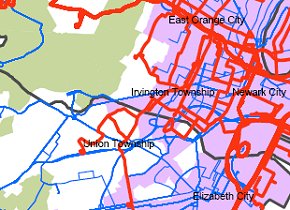After intense pressure from riders across the state, NJ Transit announced today that it will reduce its planned fare increase for local bus and light rail riders to 10% but maintain 25% fare increases for commuter rail and long distance buses. Service cuts on local buses will also be reduced, and Access Link cuts restored. The agency plans to vote on the final proposal at its board meeting on Wednesday.
While the transit cuts have received substantial press from reporters and editorial boards in the state, there are a few issues and angles that haven’t made it to the front pages.

Questions over equity analysis. On Friday, TSTC sent a letter to the NJ Transit Board of Directors requesting that they postpone Wednesday’s vote until the agency releases studies detailing how the fare and service proposal will impact low income and communities of color. NJ Transit is required by the FTA, pursuant to the Civil Rights Act of 1964, to conduct this analysis during the planning and programming stages of service proposals and seek to minimize the impacts on vulnerable communities. But NJ Transit hasn’t completed it, according to a response to TSTC’s Open Public Records Request last week. TSTC also sent maps showing the disproportionate impact of the cuts on cities like Newark, Trenton, and Camden. Even with the changes announced today, questions still remain about whether the agency is doing what it can to reduce the impact on these communities.
Use stimulus funds to stop cuts. Also last week, 26 labor, businesses, planning and transportation organizations sent a letter to Governor Christie calling on him to use $42 million in ARRA funds to postpone the service cuts and fare increases. That would plug the gap created by Governor Christie’s $33 million cut to the system, until Governor Christie and his colleagues can “find a longer term solution to the transportation funding crisis in the state.” (The state’s main source of transportation funding, the Transportation Trust Fund, will be exhausted by July 2011.) As of December 31, 2009, NJ Transit had spent $125 million of the $426 million it was promised under the American Reinvestment and Recovery Act. Transit riders can urge the governor to use these funds through TSTC’s website.
Use toll revenue for transit. Governor Christie cut $33 million from NJ Transit’s budget, but the agency’s proposal will save $126 million. According to NJ Transit, this is because it anticipates further cuts in funding in the fiscal 2011 budget, currently being discussed in Trenton, and the loss of one-time federal funds (as mentioned above, the agency still has stimulus funds available, however). The agency is clearly struggling and has been for some time. NJDOT Commissioner James Simpson responded last week, noting one possible solution would be to use toll revenue as a dedicated funding source for transit service. “It’s good policy to have highways fund transit,” he said, “because each person on transit is one less on the highways.”
NJ Transit is not alone. Transportation for America recently released a map showing that transit systems across the country are facing cuts. Unfortunately, Congress hasn’t been able to address what is a national transit crisis unlike any in the country’s recent history.
Image: From TSTC mapping of NJ Transit bus service cut proposals (note that these reflect the original service cut proposal, not the revised proposal).

[…] Originally planning to raise fares 25% across the board with significant service cuts, the agency scaled back the proposal, reducing the local bus and light rail fare increases to 10% and restoring service on the Access […]
[…] class get off with little to know cuts. Honestly when i thought this state can't go any lower. Behind the NJ Transit Headlines | Mobilizing the Region Poor and urban areas are where I see the buses packed. Doesn't make sense to […]
[…] class get off with little to know cuts. Honestly when i thought this state can't go any lower. Behind the NJ Transit Headlines | Mobilizing the Region I suspect that in poor and urban areas there are far more routes so of course they would be […]
You may want to overlay the lines that they are not cutting in the poorer areas also, it’ll show you something entirely different. Look at it from every angle. Your view is as small as a needle hole.
NAA, the maps include all NJ Transit bus lines, including the ones which did not receive any service cuts (they are shown in blue).